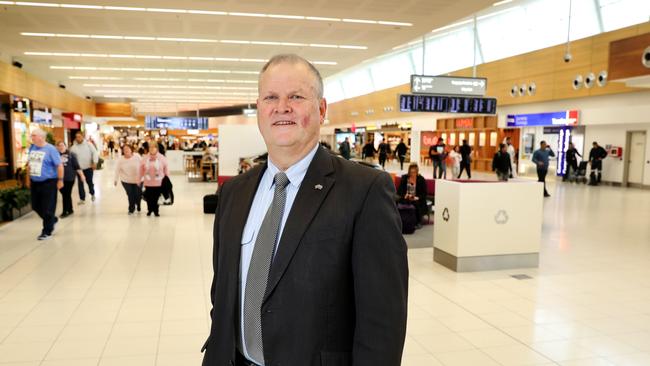Adelaide Airport’s profits fell off cliff due to COVID but it has solid base to rebuild from
It’s been a torrid time for travel operators, with airports at the pointy end of the COVID-19 impact, but Adelaide Airport says it’s on a firm footing.

SA Business
Don't miss out on the headlines from SA Business. Followed categories will be added to My News.
Adelaide Airport’s profit halved last financial year and it will cut its staff costs by 20 per cent, but says it’s on a firm financial footing to come through the COVID-19 pandemic.
The Airport’s “Integrated Review”, released along with its financial report, says it does not expect a return to pre-COVID travel levels “for three to four years’’.
The Airport was tracking strongly for the first half of the year, with passenger numbers up 4.4 per cent, underpinned by record international traffic, up 12.7 per cent.
But it’s been a game of two halves.
“During the COVID-19 pandemic, passenger numbers fell by 96 per cent, with effectively zero international traffic in April and May,’’ the airport says in its annual report.
“Our biggest carrier, Qantas, did not fly domestically to Adelaide for two months. The strong Fly-in Fly-out market on the back of a resilient mining industry maintained 30 per cent of regional passengers. The net result was a 24.1 per cent fall in passenger numbers compared to 2019.’’
The Airport has stopped paying dividends to its superannuation fund owners, and its net profit fell from $43.7 million to $21.4 million.
Managing director Mark Young told The Advertiser that the airport was currently “trading in a cash positive way’’ and was “poised to move” as the aviation sector recovered.
The Airport has stopped “non-critical” capital expenditure but is continuing with its terminal expansion project which will be finished in late 2021.

The Airport has income streams from airlines, but also from retail, property and carparking, with all affected in some way.
“Given the rapidly evolving situation, it is not possible to predict the extent of the financial impact, which is and continues to be material,’’ the airport said.
“The current forecast does not see a return to pre-COVID-19 levels for three to four years.
“With appropriate risk assessments and health initiatives, we anticipate our passenger volumes will recover to 2019 levels by the 2023/24 financial year.’’
The report notes however, that the aviation industry may be fundamentally changed as a result of the pandemic.
“The aviation industry, including airports, has been brought to a virtual halt and the industry is in survival mode,’’ the report says.
“The future is no doubt challenging. We will need to rebuild our entire international network. Airlines will equally have tough decisions to make on their network capacity, so it will require significant effort to recover what we had in a post-COVID-19 environment.’’
While noting that its financial models contain a number of uncertainties, the Airport said its property portfolio in the wider airport precinct had performed well and held it in good stead.
“While the full duration and scope of the COVID-19 pandemic cannot be known at this time, based on the scenarios modelled, the group believes that the pandemic will not have a material impact on the long-term financial sustainability of the group.
“The strong market position and diversification of the business has assisted with forming this conclusion.’’
Part of the Airport’s pandemic response included reducing salaries of board members, executives and the majority of employees by 20 per cent.
A restructure announced in August would also reduce labour costs by 20 per cent. Mr Young said he wouldn’t give an exact figure on how many staff left the organisation, saying it was “very sad that we had to restructure and have very valuable people leave the company’’.
The Airport received $1.95 million in JobKeeper assistance payments from April to June.


